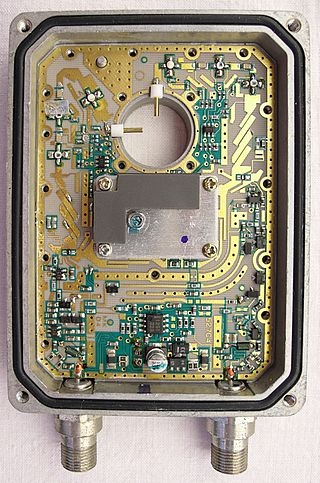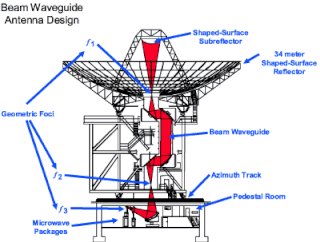
In telecommunications and radar, a Cassegrain antenna is a parabolic antenna in which the feed antenna is mounted at or behind the surface of the concave main parabolic reflector dish and is aimed at a smaller convex secondary reflector suspended in front of the primary reflector. The beam of radio waves from the feed illuminates the secondary reflector, which reflects it back to the main reflector dish, which reflects it forward again to form the desired beam. The Cassegrain design is widely used in parabolic antennas, particularly in large antennas such as those in satellite ground stations, radio telescopes, and communication satellites.
Television receive-only (TVRO) is a term used chiefly in North America, South America to refer to the reception of satellite television from FSS-type satellites, generally on C-band analog; free-to-air and unconnected to a commercial DBS provider. TVRO was the main means of consumer satellite reception in the United States and Canada until the mid-1990s with the arrival of direct-broadcast satellite television services such as PrimeStar, USSB, Bell Satellite TV, DirecTV, Dish Network, Sky TV that transmit Ku signals. While these services are at least theoretically based on open standards, the majority of services are encrypted and require proprietary decoder hardware. TVRO systems relied on feeds being transmitted unencrypted and using open standards, which heavily contrasts to DBS systems in the region.
A satellite dish is a dish-shaped type of parabolic antenna designed to receive or transmit information by radio waves to or from a communication satellite. The term most commonly means a dish which receives direct-broadcast satellite television from a direct broadcast satellite in geostationary orbit.

A parabolic antenna is an antenna that uses a parabolic reflector, a curved surface with the cross-sectional shape of a parabola, to direct the radio waves. The most common form is shaped like a dish and is popularly called a dish antenna or parabolic dish. The main advantage of a parabolic antenna is that it has high directivity. It functions similarly to a searchlight or flashlight reflector to direct radio waves in a narrow beam, or receive radio waves from one particular direction only. Parabolic antennas have some of the highest gains, meaning that they can produce the narrowest beamwidths, of any antenna type. In order to achieve narrow beamwidths, the parabolic reflector must be much larger than the wavelength of the radio waves used, so parabolic antennas are used in the high frequency part of the radio spectrum, at UHF and microwave (SHF) frequencies, at which the wavelengths are small enough that conveniently sized reflectors can be used.

A low-noise block downconverter (LNB) is the receiving device mounted on satellite dishes used for satellite TV reception, which collects the radio waves from the dish and converts them to a signal which is sent through a cable to the receiver inside the building. Also called a low-noise block, low-noise converter (LNC), or even low-noise downconverter (LND), the device is sometimes inaccurately called a low-noise amplifier (LNA).
Super high frequency (SHF) is the ITU designation for radio frequencies (RF) in the range between 3 and 30 gigahertz (GHz). This band of frequencies is also known as the centimetre band or centimetre wave as the wavelengths range from one to ten centimetres. These frequencies fall within the microwave band, so radio waves with these frequencies are called microwaves. The small wavelength of microwaves allows them to be directed in narrow beams by aperture antennas such as parabolic dishes and horn antennas, so they are used for point-to-point communication and data links and for radar. This frequency range is used for most radar transmitters, wireless LANs, satellite communication, microwave radio relay links, satellite phones, and numerous short range terrestrial data links. They are also used for heating in industrial microwave heating, medical diathermy, microwave hyperthermy to treat cancer, and to cook food in microwave ovens.

A horn antenna or microwave horn is an antenna that consists of a flaring metal waveguide shaped like a horn to direct radio waves in a beam. Horns are widely used as antennas at UHF and microwave frequencies, above 300 MHz. They are used as feed antennas for larger antenna structures such as parabolic antennas, as standard calibration antennas to measure the gain of other antennas, and as directive antennas for such devices as radar guns, automatic door openers, and microwave radiometers. Their advantages are moderate directivity, broad bandwidth, low losses, and simple construction and adjustment.

A parabolic torus reflector antenna is a quasi-parabolic antenna, where the defining parabola is not rotated around the main transmission axis, but around an axis which stands vertically to this axis.

A microwave antenna is a physical transmission device used to broadcast microwave transmissions between two or more locations. In addition to broadcasting, antennas are also used in radar, radio astronomy and electronic warfare.

An orthomode transducer (OMT) is a waveguide component that is commonly referred to as a polarisation duplexer. Orthomode is a contraction of orthogonal mode. Orthomode transducers serve either to combine or to separate two orthogonally polarized microwave signal paths. One of the paths forms the uplink, which is transmitted over the same waveguide as the received signal path, or downlink path. Such a device may be part of a very small aperture terminal (VSAT) antenna feed or a terrestrial microwave radio feed; for example, OMTs are often used with a feed horn to isolate orthogonal polarizations of a signal and to transfer transmit and receive signals to different ports.

An offset dish antenna or off-axis dish antenna is a type of parabolic antenna. It is so called because the antenna feed is offset to the side of the reflector, in contrast to the common "front-feed" parabolic antenna where the feed antenna is suspended in front of the dish, on its axis. As in a front-fed parabolic dish, the feed is located at the focal point of the reflector, but the reflector is an asymmetric segment of a paraboloid, so the focus is located to the side.
A radio transmitter or receiver is connected to an antenna which emits or receives the radio waves. The antenna feed system or antenna feed is the cable or conductor, and other associated equipment, which connects the transmitter or receiver with the antenna and makes the two devices compatible. In a radio transmitter, the transmitter generates an alternating current of radio frequency, and the feed system feeds the current to the antenna, which converts the power in the current to radio waves. In a radio receiver, the incoming radio waves excite tiny alternating currents in the antenna, and the feed system delivers this current to the receiver, which processes the signal.

A block upconverter (BUC) is used in the transmission (uplink) of satellite signals. It converts a band of frequencies from a lower frequency to a higher frequency. Modern BUCs convert from the L band to Ku band, C band and Ka band. Older BUCs convert from a 70 MHz intermediate frequency (IF) to Ku band or C band.
Low-noise block downconverters (LNBs) are electronic devices coupled to satellite dishes for TV reception or general telecommunication that convert electromagnetic waves into digital signals that can be used to transform information into human or machine interpretable data, e.g., optical images, video, code, communications, etc.

Satellite television is a service that delivers television programming to viewers by relaying it from a communications satellite orbiting the Earth directly to the viewer's location. The signals are received via an outdoor parabolic antenna commonly referred to as a satellite dish and a low-noise block downconverter.

A focal cloud is the collection of focal points of an imperfect lens or parabolic reflector whether optical, electrostatic or electromagnetic. This includes parabolic antennas and lens-type reflective antennas of all kinds. The effect is analogous to the circle of confusion in photography.

The Squarial was a satellite antenna used for reception of the now defunct British Satellite Broadcasting television service (BSB). The Squarial was a flat plate satellite antenna, built to be unobtrusive and unique. BSB were counting on the form factor of the antenna to clearly differentiate themselves from their competitors at the time. At the time of development, satellite installations usually required a 90 cm dish in order to receive a clear signal from the transmitting satellite. The smaller antenna was BSB's unique selling point and was heavily advertised in order to attract customers to their service.

A Duo LNB is a double low-noise block downconverter (LNB) developed by SES for the simultaneous reception of satellite television signals from both the Astra 23.5°E and Astra 19.2°E satellite positions.

A beam waveguide antenna is a particular type of antenna dish, at which waveguides are used to transmit the radio beam between the large steerable dish and the equipment for reception or transmission, like e.g. RF power amplifiers.
In radio systems, many different antenna types are used whose properties are especially crafted for particular applications. Antennas can be classified in various ways. The list below groups together antennas under common operating principles, following the way antennas are classified in many engineering textbooks.
















